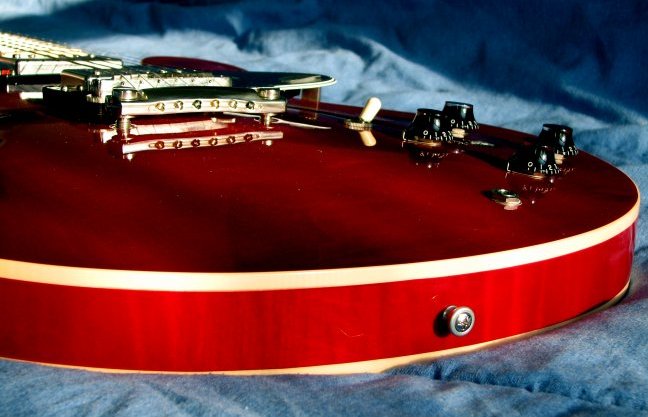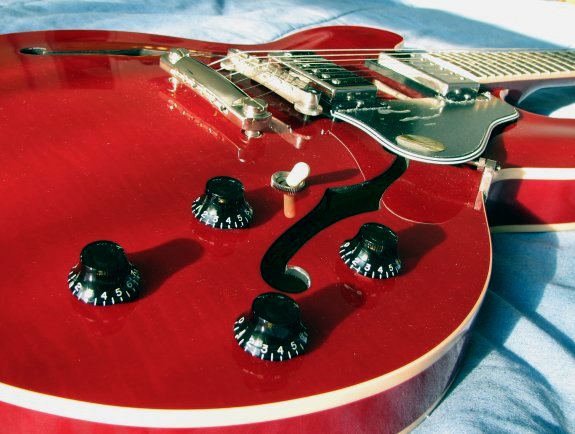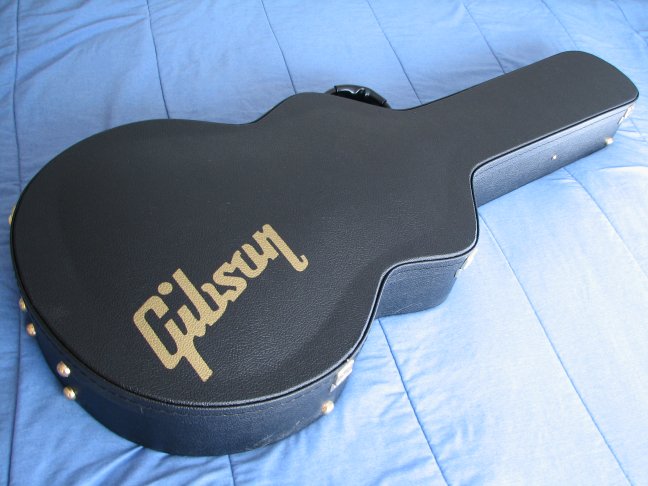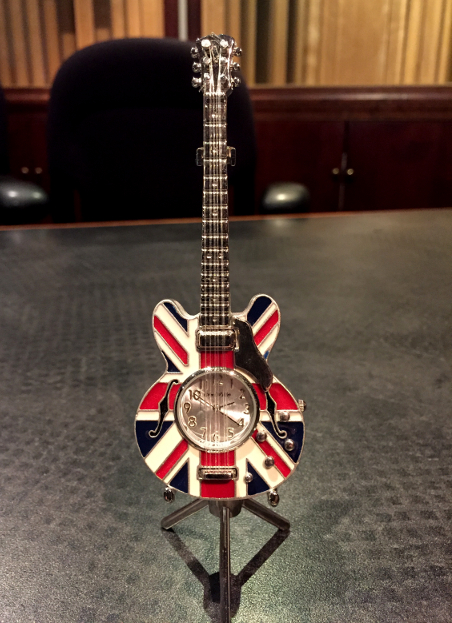Gibson Memphis ES-335 DOT Reissue, a Review

Events conspire once again, and an old dog learns a new trick. Shocking.
I’ve played some of the classic electric guitars over the years. Between the various types, they could produce many of the sounds I need. But there have been some sounds that had a character about them that eluded me, even though they were usually fairly simple, moderate-gain sounds. As it turns out, the main reason was that while I had listened to others use it, I had never really explored one type of guitar myself: the semi-hollow electric. This design innovation was introduced by Gibson in 1958 with their ES335 model and has gone on to be one of the most successful electric guitar designs of all time. The basic concept is to place a solid center block within a hollow body form, spanning the space from the neck to the endblock. Thus, the neck and the tailpiece are given more rigid mountings, imparting greater sustain than that of a pure hollow body. While the pickups are mounted into this block, the top vibration is introduced into them, adding complexity and warmth.
Recently as I watched a couple of videos in particular where the lead guitarists used this type of guitar, the sounds they were able to produce really caught my ear. On one video I was given a kind of “guided tour” of the familiar semi-hollow sounds that had been created over the years. That video was Amy Grant’s Time Again and the guitarist was the late, great Will Owsley. The guitars in play were an early ‘60s ES335 and a Gretsch 6150.* Those two semi-hollow guitars had a certain “twang” in their bridge pickups and a “sweetness” in their neck pickups that weren't available in the solid guitars I'd played. The other video was The Allman Brothers Live at the Beacon Theater, 2003, throughout which Warren Haynes traded off between a couple of Les Pauls and a couple of ES335s. Once again, there was a complexity and sweetness in the ES tone that wasn’t there in the solid guitars. Now, mind you, the guitarists in these videos were playing vintage ES335s from the early ‘60s, the kind that are climbing the desirability charts right now in vintage circles and fetching upwards of $18k. As a working-class stiff, there is just no way I’m able to shell out that kind of money. The guys in these two videos, both of them vintage guitar enthusiasts, had cherry-picked their guitars for that great sound they produced. After watching these two videos and a couple of YES videos where Steve Howe used his ES345, I shoved off to the guitar stores on another one of my crazy information quests. Armed with my trained ears and a sound in my head, I decided to discover whether it is possible to get those vintage sounds from modern production guitars. Now, mind you, this started out as simply a fact-finding mission.

So, now that I’ve gotten the guitar home and have begun experimenting with it, how is it holding up to scrutiny? Actually, very well. What has fascinated me has been all the familiar tones from rock and roll, blues, and jazz, that have begun to just “fall out of it.” In particular, some classic blues tones just oozed out of the guitar. During my experiments, it seemed that whenever the word “sweet” came to mind as a term to describe an electric guitar in a song, I could make the right sound fall into place with the ES and a Fender amp. I also discovered that the ES is a guitar that encourages you to back off the gain so you can hear its clean tone better. Many of the classic ES tones revolve around that. Another round of experimentation has involved setting up the gain to the point where overdrive is just barely discernable, adding a little bit of reverb, delay, and compression, and playing with the guitar’s volume and tone controls. I’ve got to say the Larry Carlton thing falls right out, both his bridge pickup sound and his beebop neck pickup sound. The guitar’s ‘57 Classic humbucking pickups have plenty of airy high-end, enough that you can actually work with the volume and tone controls much more than on a Les Paul. Frankly, I think these are some of the nicest pickups Gibson has created in recent years. Many Gibson-lovers think they've finally gotten the PAF sound from the late-'50s pickups dialed in. The guitar came equipped with Gibson's "Bright Wires" nickle-plated steel strings in light gauge (.010), which, I'm sure, contributed to the bright, airy sound. I haven't had the chance to try pure nickle vintage strings with their darker sound on the guitar yet. The overall tonal effect of the ES335 is something like the Les Paul, but the ES has less midrange so the highs seem a little more present. The semi-hollow construction also imparts a woody sound and some complexity to the body of the guitar's sound. Where the Les Paul's sustain phase is at a volume close to its attack, giving it the "go away and have a sandwich and it'll still be ringing when you come back" sustain, the ES has a nice round attack followed by a slight fade, then a reduced volume sustain phase. The result is a sound that can certainly rock out but offers you some more mellow possibilities as well.
So, how does the instrument look and feel? Well, part of the vintage gang maintains that this current version is so unlike the ‘50s and ‘60s as to not be the same instrument. Another faction of the vintage gang says it is so close to the original that the differences are miniscule. Apparently Gibson has ceased production of their “Historic” line now that this version has hit the street. Does that mean anything? I’m not sure. Me? As a player, I’d say perhaps it is a pretty close copy of the original with a few modern changes. Though listed as a “1960 Slim Taper” neck profile, the neck shape isn’t exactly like the 1960 ones. While it is slim, it has a more “D” shaped profile with flatter shoulders that fill out the palm a bit more than the “boat” shaped originals. This is not the most comfortable neck I've ever played, but oddly, it is the fastest by a wide margin. I had always thought the two were synonymous. Time for another re-think. There are also complaints from some vintage-lovers that Gibson chose to fit this model with Grover tuners with kidney bean shaped keys rather than the Klusons that came with the originals. Having owned and played Gibsons in the ‘70s and seen many since, I can tell you that the first things to get tossed on the Gibsons were the Klusons, because many felt they didn’t hold tune particularly well, especially when you bent strings. They were inevitably replaced with, you guessed it, kidney bean Grover keys. I, for one, welcome the change.
How about fit and finish? Overall, the guitar was delivered with a gorgeous finish over some very lovely, moderately-figured flame maple veneer. Of course, therein lies another controversy that has some of the vintage boys crying foul: In the original runs, figured maple veneer was as rare as hound’s teeth, making the average 335 a plain top. There are historic examples, such as THIS example over at the ES335 Historic site. Fear not, there are plain tops out there in the new run for those that prefer them. My particular example has moderate flame that I find very pretty on front, back, and sides. It had a few minor finish flaws in inconspicuous places, including a little “orange peel” along the top side of the headstock. Frankly, having played Gibsons for much of my thirty-six years of playing and having seen how they are built, I don’t expect perfection in their finishes. The others at the store each had their own problems. Still, this one was pretty darned nicely finished. It was delivered with a part missing: The little final acorn nut on the pickguard mount in the waist was gone when I picked it up. If you look closely, you can see its absence in the pics. Two days after a call to the pleasant folks at Gibson customer service, a bag with all the mounting hardware for the 'guard showed up at my door. Pleasant indeed.
Frets, neck, fingerboard and action? The guitar has a very nice piece of dark rosewood for the fingerboard that turns out to have been nicely leveled. There are twenty-two narrow but tall frets on the neck, mic’ing out at from .051 to .055 in height. As delivered, it had a reasonably nice action and fret finish with only a few sharpish fret ends, particularly on the treble side up near the top of the neck, but nothing really out of the ordinary for a factory-produced guitar. The neck was pretty straight, side to side, though by the time it arrived home there was a little too much relief. As usual, I turned it over to my technician, Ken Marshall, at Norfolk’s Audio, Light, & Musical, to have it set up and get a baseline on the instrument. Ken describes himself as a “playability specialist”, and I agree that he is able to work magic with a guitar’s frets and action. Ken was able to bring the guitar into my spec, give it a modern setup, and dress it to feel extremely nice and broken in, without too much effort. Before the setup, the fingerboard finish was a little rustic, with tool marks left from production. Given the fact that Gibson binds the fret ends of this model and has to level the binding with the frets in place, Ken chuckled and described this effect as “authentic”. After the setup, the guitar felt nicely broken in and extremely comfortable, basically like a million dollars, pretty much as good as it sounded.
So, if you are looking for that classic ES335 sound in a modern instrument from Gibson, they are out there in the form of the Memphis ES335 DOT Reissue, and the current build quality is good enough to make it worth your while to pursue one. There are minor flaws, but no more than I’ve experienced in any other Gibsons including those from the late ‘50s and early ‘60s. With a setup, the current ES335 can feel and sound very much like a nicely broken-in vintage one. And the sounds are definitely in there.
Connections: Many of the classic West Coast ES sounds were created with the guitar running through a one knob “squeezer” type of compressor, such as the MXR DynaComp. I’ve been easily able to reproduce that sound with my POD. With the nice round attack the guitar has, it makes me want to try out one of the more modern compressors that allow you to preserve the attack and compress only the sustain phase of the guitar’s tone. Right after the guitar came home I located a video with Joe Walsh playing the songs from his "So What?" album live and discovered that he was going through an ES-335 phase then. No wonder I hadn't been able to match his sounds with my Les Paul in that period!
Specs for the reviewed example:
Body: Laminated maple/poplar/maple with maple center block
Neck: One piece mahogany, 1960 Slim taper, single-ply binding
Fingerboard: rosewood (a nice dark piece)
Fingerboard Inlays: Dots
Headstock Inlay: ES "Crown" inlay
Hardware: Nickel
Pickups: ’57 Classic
Tuners: Grover, with “kidney bean” keys
Bridge: ABR-1 with retaining wire, and stop tailpiece
Finish: Nitrocellulose
Color: Transparent cherry over moderately figured maple (front, back, and sides)
Body binding: Single-ply cream
Pick guard: Five-ply black/white/black
Knobs: Black top-hats with pointers
Included accessories: Nicely-built, Gibson-branded TKL arch-top case with silver-grey lining and shroud, truss rod tool.
ADDENDUM: I've had the opportunity to record the guitar. HERE is a short, rustic recording created to test out a new piece of recording gear. The sounds were created with the bridge pickup. The tone control was rolled back to "6".
*The Amy Grant video was shot over two nights of concerts. As directors often do, the director of this video chose a master "best take" of each song and intercut shots from both nights to make an interesting final product. Hilariously, it appears that Will switched song assignments freely between the red Gibson dual cutaway ES335 and orange Gretsch 6150 single cutaway on the two nights. As the director intercuts (and he cuts pretty frequently), Will's guitar magically changes color and shape, often for as little as a second at a time! Gibson/Gretsch/Gibson/Gretsch/etc. Amy giggles about that and about Will's "guitar face" on the artist commentary track.



